AI in Government RFP Workflow: Tips and Examples
Streamline your government RFP workflow with AI. Cut response time, boost compliance, and see real results from automation. Explore how it works.
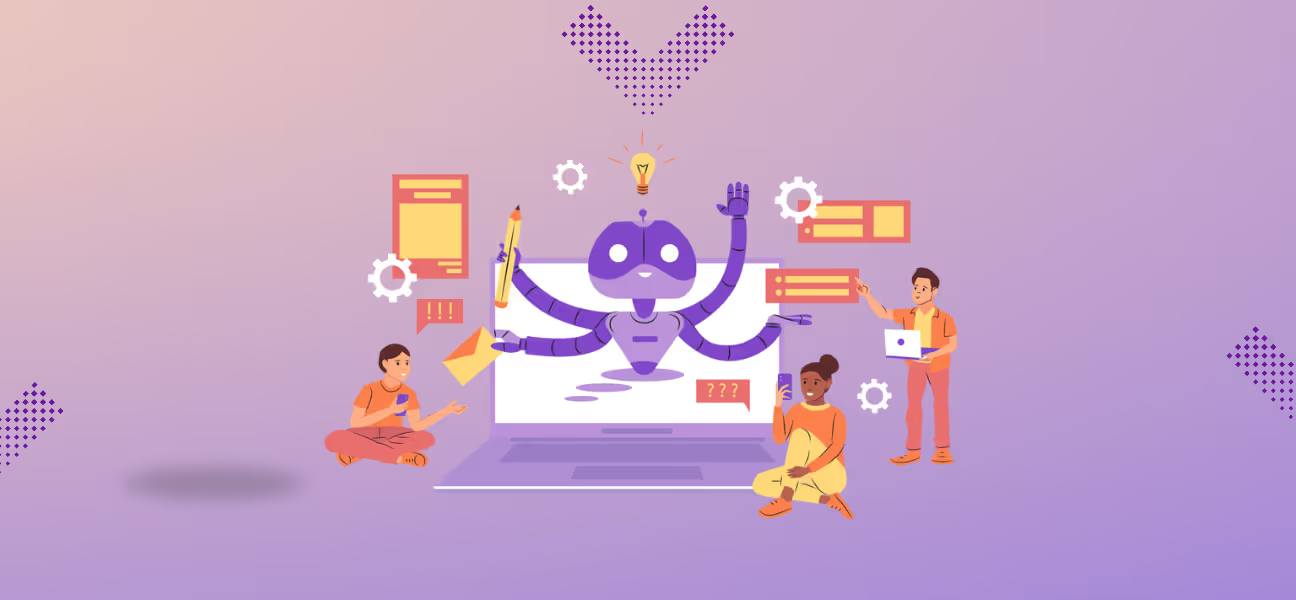
Government agencies often take a lot of time to finalize large Request For Proposal (RFP) due to manual processes, disjointed collaboration, and structural inefficiencies, causing delays and frustration for agencies and vendors alike.
In an environment where compliance is non-negotiable and public accountability is paramount, these delays translate into missed opportunities, budget overruns, and strained vendor relationships.
That’s where Artificial Intelligence (AI) is starting to make a measurable impact. AI helps public sector procurement teams simplify workflows by automating drafting, enhancing vendor evaluation, and tracking compliance while maintaining regulatory integrity.
To understand how AI is reshaping this complex process, let’s start by breaking down what the government RFP workflow entails.
TL;DR
- AI accelerates government RFP timelines by automating tasks like drafting, document search, and internal collaboration, cutting response times by up to 90%.
- Compliance and risk management improve with AI that flags outdated clauses, monitors certifications, and enforces audit-ready standards.
- Tools like Inventive AI boost win rates by tailoring responses to agency needs and maintaining a centralized, accurate knowledge base.
- Agencies and vendors save time and resources, converting once-manual processes into smart, efficient workflows.
- Early pilots and content audits ensure smooth AI adoption, especially in complex, compliance-heavy public sector environments.
What Is a Government RFP Workflow?

The government RFP workflow refers to the structured, multi-phase process through which public sector agencies procure goods and services from external vendors. Unlike private sector procurement, government RFPs must meet strict requirements around transparency, fairness, and compliance, making the process more rigid and documentation-heavy.
A typical government RFP workflow includes:
- RFP Drafting: Creating detailed scopes of work, legal terms, evaluation criteria, and submission guidelines.
- Internal Review & Stakeholder Alignment: Involving legal, finance, compliance, and technical departments for approvals.
- Public Posting & Vendor Outreach: Publishing the RFP on official portals and notifying qualified vendors.
- Bid Collection & Response Evaluation: Receiving vendor proposals, validating qualifications, and scoring submissions.
- Award, Contracting & Audits: Selecting a vendor, issuing contracts, and maintaining full audit trails for regulatory review.
While these steps are essential for transparency, the traditional way they’re handled creates major roadblocks. Let’s explore what makes the process so challenging.
Why Is It Challenging?
Traditional government RFP workflows are often burdened by structural inefficiencies that make the process slow, error-prone, and frustrating for both agencies and vendors. These challenges typically include the following:
- Manual Document Creation and Inconsistent Formatting: RFPs are frequently drafted from scratch using word processors or outdated templates, leading to inconsistencies in language, structure, and requirements. This increases the chance of errors and creates confusion for vendors interpreting vague or misaligned instructions.
- Siloed Data Across Departments: Critical information, from compliance requirements to technical specs, is often stored across multiple systems or managed by different departments (legal, finance, procurement). The lack of centralized access leads to delays, miscommunication, and duplication of work as teams struggle to stay aligned.
- Repetitive Evaluation Tasks and Time-Consuming Scoring Processes: Reviewing vendor proposals often requires multiple evaluators scoring against lengthy criteria spreadsheets. Without automation, this becomes a tedious, error-prone process vulnerable to bias, inconsistency, or oversight, especially for high-volume bids.
- Limited Reuse of Prior RFPs or Bid Data: Agencies rarely have easy access to historical RFPs or successful response templates. As a result, teams reinvent the wheel for each procurement cycle, spending unnecessary time redrafting requirements and recreating evaluation frameworks from scratch.
- Compliance Bottlenecks: Every RFP must adhere to strict federal, state, or local procurement rules. A single missing clause, outdated certification, or ambiguous evaluation criterion can trigger audits, formal protests, or legal challenges, stalling the entire procurement process and damaging public trust.
These challenges make government procurement one of the most resource-intensive workflows in the public sector. The need for efficiency without sacrificing compliance is what makes AI such a timely and powerful solution.
Fortunately, AI offers powerful solutions to these issues. Let’s look at how it transforms every stage of the government RFP workflow.
How AI Contributes to the Government RFP Workflow?
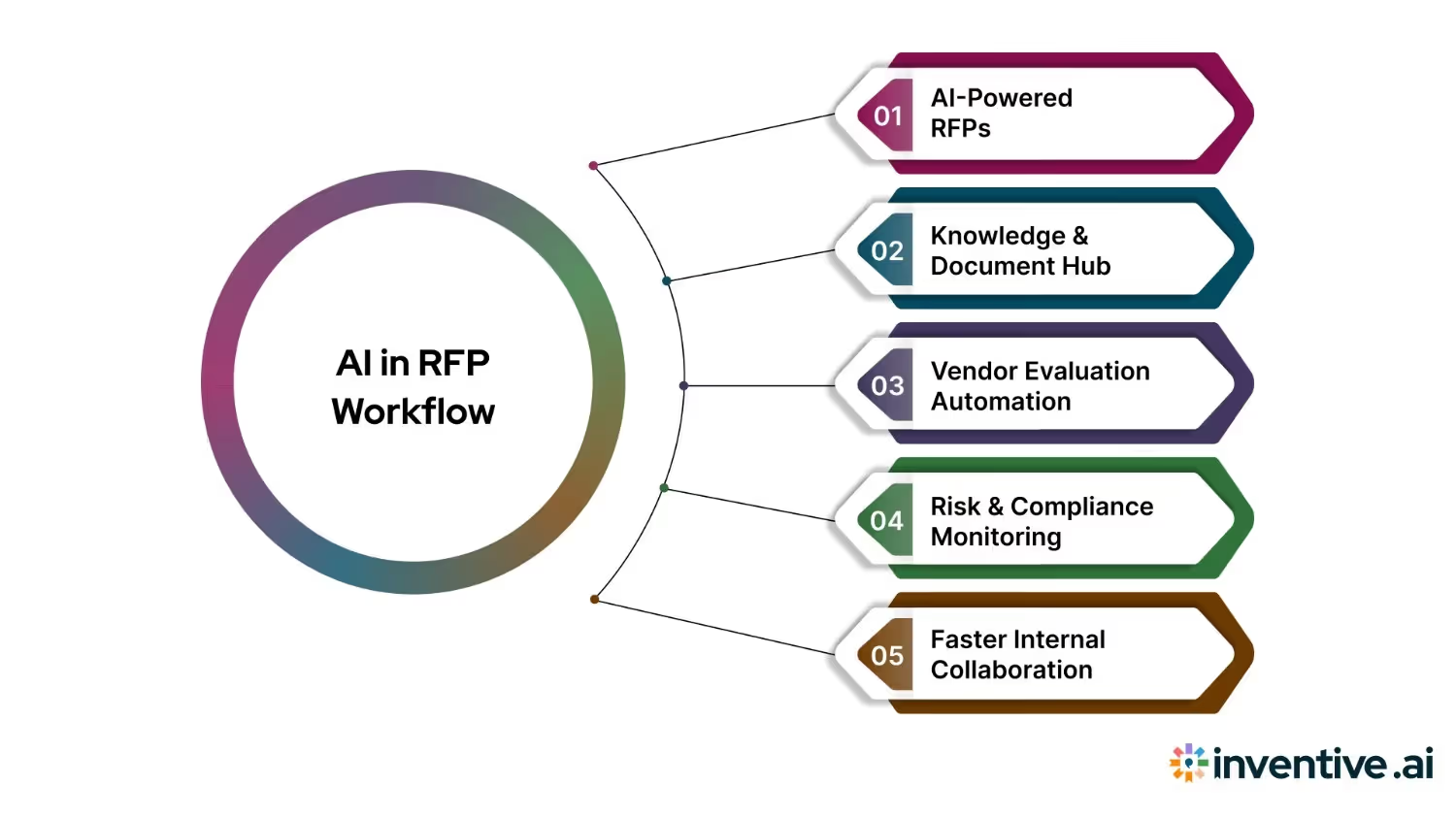
Government RFPs are designed to promote transparency, fairness, and value but the traditional workflows behind them are often slow, manual, and inconsistent. By introducing AI, public agencies can modernize each stage of the procurement lifecycle without compromising on compliance or auditability.
Here’s how AI-powered tools reshape each stage of the RFP workflow:
1. Smarter RFP Drafting
RFP drafting means writing or copying large sections from scratch, often leading to inconsistency, outdated language, or legal risk. AI addresses this by analyzing historical procurement data, past contracts, compliance language, and preferred templates to generate first drafts automatically.
These drafts can include:
- Standardized terms for data privacy, sustainability, or local labor laws
- Pre-vetted clauses tailored to specific project types
- Auto-filled timelines, requirements, and evaluation criteria
Example: A state transportation department uses an AI drafting assistant trained on 10 years of infrastructure project RFPs. The tool suggests environmental compliance language and preapproved scope formats for highway expansions, reducing RFP creation time by over 70%.
2. Centralized Knowledge and Document Management
Government procurement involves numerous documents, RFPs, clarifications, prior responses, vendor Q&As. When stored across email inboxes, spreadsheets, and shared drives, retrieving relevant materials becomes a time sink.
AI-powered platforms index and categorize documents using Natural Language Processing (NLP), enabling users to quickly retrieve relevant information through intuitive natural-language queries.
Example: A federal agency’s procurement office uses AI to consolidate thousands of historical solicitations and vendor evaluations. When drafting a new cloud services RFP, the tool pulls approved language and vendor scoring models from prior solicitations in seconds.
3. Automated Vendor Evaluation
Scoring vendor responses often involves multiple stakeholders and scoring matrices, which can introduce bias, inconsistency, or delays. AI reduces bias and errors by automatically scoring proposals based on weighted criteria, flagging incomplete or non-compliant bids, and calculating total cost of ownership alongside compliance risk scores.
Example: A municipal IT department uses an AI tool to evaluate vendor bids for a data center upgrade. The software auto-scores technical capabilities and SLA commitments, freeing up reviewers to focus on qualitative inputs like innovation or community impact.
AI scoring also improves transparency, as every score and decision is auditable, traceable, and aligned with published criteria, crucial in the event of a vendor protest.
4. Risk and Compliance Monitoring
Public agencies are held to strict procurement standards. Missing certifications, ethical violations, or poor past performance can lead to vendor protests, reputational damage, or legal scrutiny.
AI continuously monitors vendor risk by detecting regulatory violations, lawsuits, financial instability, tracking compliance certifications like FedRAMP and ISO; and checks sanction lists and procurement blacklists to ensure adherence.
Example: A U.S. federal agency used AI during a cybersecurity RFP to automatically assess vendor compliance. The AI flagged one bidder due to a recent lawsuit and identified another with an expired ISO 27001 certification. It also checked sanction lists, disqualifying a non-compliant vendor.
This automated monitoring helped the agency avoid risk, ensure compliance, and streamline evaluation, all in real time. What once took days of manual review was completed in minutes, allowing the procurement team to focus on qualified vendors while maintaining full audit readiness and transparency throughout the selection process.
5. Faster Internal Collaboration
One of the biggest bottlenecks in public procurement is internal coordination. Legal, compliance, finance, and technical teams must all review, approve, and contribute to RFPs, often through back-and-forth emails or disjointed comment threads.
AI accelerates this by:
- Assigning tasks automatically based on workflow stage
- Tracking document versions and reviewer inputs
- Integrating with tools like Microsoft Teams, Outlook, SharePoint, and procurement ERPs
Example: A city council’s procurement office implements an AI-enabled collaboration dashboard. It sends automated reminders to legal reviewers, tracks who has signed off on each section, and highlights sections with unresolved comments, shortening internal review cycles by 50%.
These benefits aren’t just theoretical. Real-world case studies show how AI delivers measurable results.
Also Read: RFP Content Management Tips for Better Responses
Case Study: 50% Higher Win Rate & 90% Faster RFP Responses
Insider, a global leader in personalized marketing, partnered with Inventive.ai to overhaul its RFP workflow using AI-powered tools, achieving transformative efficiency and quality results.

Challenge: Manual & Time-Consuming RFP Process
Insider’s teams relied heavily on Google Sheets for Q&A, resulting in slow, error-prone content retrieval and frequent last-minute panics.
Solution: AI Agents & Centralized Knowledge Hub
- Within five days, Insider built a unified knowledge hub by uploading past RFPs and documents.
- The AI RFP Agent began generating draft responses within the same week—integrating content across Google Drive, SharePoint, and Notion.
Results That Matter
- 90% Reduction in RFP Response Time: A typical 100-question RFP dropped from 4–5 hours to just 20–30 minutes.
- 50% Higher Win Rate: Insider’s success ratio jumped from roughly 30% to 50–70%.
- No Manual Q&A Upkeep: The AI automatically maintained and updated content, eliminating content library maintenance.
- Better, Up-to-date Answers: Enhanced proposal quality through consistent, fresh, and tailored responses.
- Improved Team Morale: RFPs transformed from dreaded tasks into streamlined, engaging workflows.
What Insider Said
“Inventive has not only helped us save time, but it’s also helped us win more. Our win rate increased by more than 50% after implementing Inventive.”
— Anthony Pukal, Solutions Consultant at Insider
“Overall, my RFP workflow is SO much faster now with Inventive and we are winning more than ever before.”
— Source via press release
This case demonstrates that even complex, compliance-driven RFP environments, like government procurement, can achieve faster, more accurate, and more strategic outputs using AI-powered RFP automation. Read more about this case study here.
Want to achieve similar results in the public sector? The next section offers practical best practices for implementing AI in government RFP workflows.
5 Best Practices for Implementing AI in Government RFP Workflows
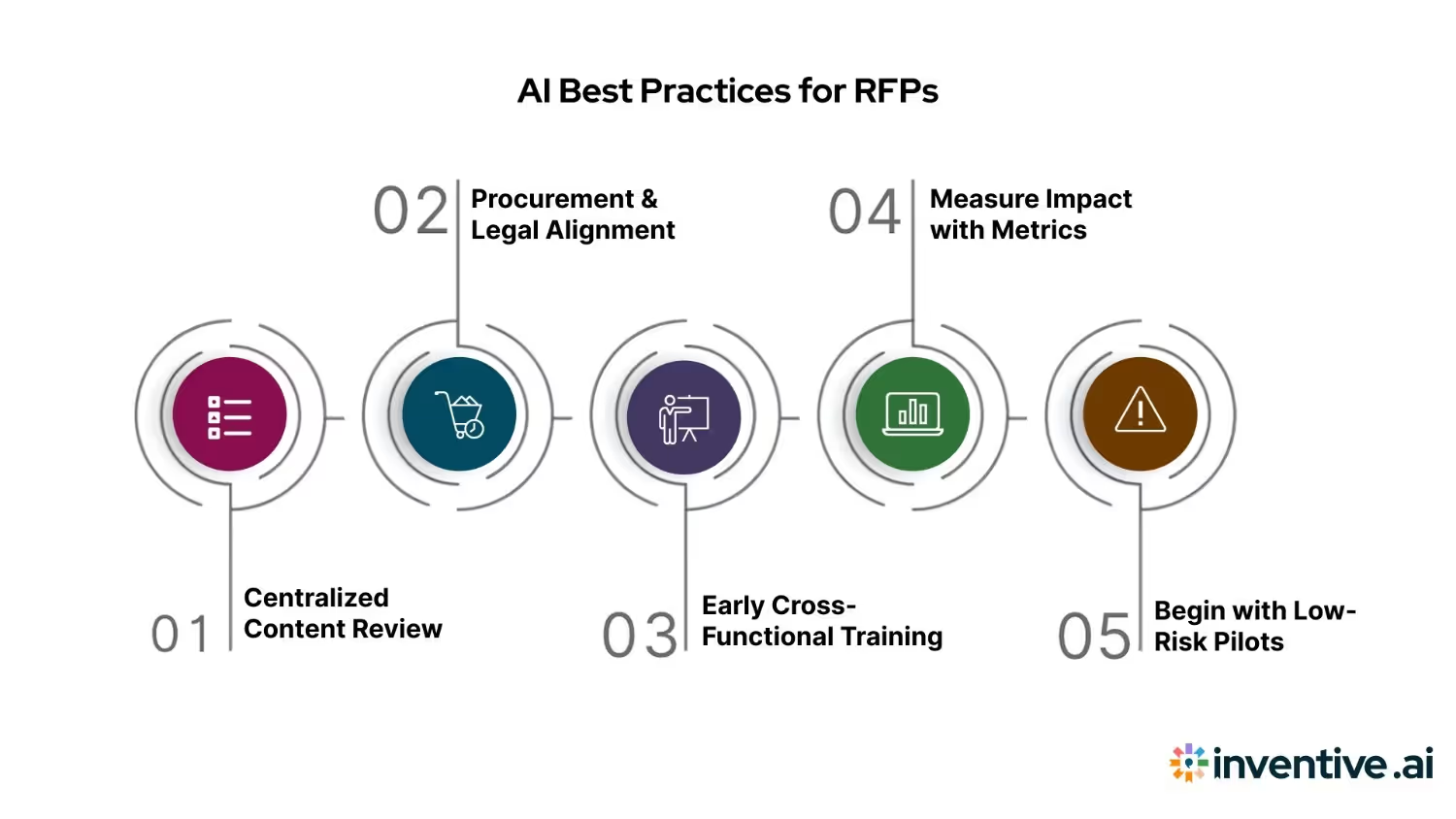
Successfully integrating AI into public sector RFP processes requires more than just new tools. It demands thoughtful change management, compliance alignment, and structured onboarding.
Below are five best practices to ensure a smooth and effective implementation:
1. Start with a Centralized Content Audit
Before deploying any AI RFP solution, audit your current proposal content, templates, and response libraries.
Why it matters: AI is only as good as the data it’s trained on. Outdated or inconsistent content leads to inaccurate responses and compliance risks.
2. Align with Procurement and Legal Compliance Standards
Government RFPs require strict adherence to local, state, and federal procurement regulations. Ensure the AI solution supports those needs.
Why it matters: Non-compliant language, missed clauses, or improper formatting can disqualify a proposal.
Tip: Select an AI RFP agent that automatically flags outdated or non-compliant content and integrates with legal-approved templates.
3. Train Cross-Functional Teams Early
AI isn’t just for proposal teams. Legal, sales, finance, and compliance teams should be looped in from day one.
Why it matters: Government RFPs typically require input from multiple departments. Streamlined collaboration allows real-time input and approval effortlessly.
Tip: Conduct role-based onboarding sessions so each team knows how to review, validate, and contribute within the AI workflow.
4. Use Metrics to Measure Impact
Track measurable outcomes to demonstrate ROI and justify ongoing use or expansion.
Why it matters: Public sector budgets are under constant scrutiny. Clear metrics build internal confidence in AI adoption.
Examples of metrics to track: RFP response time reduction (%), Proposal approval rate, Win rate increase, Time saved per proposal
5. Start with Low-Risk Pilots Before Scaling
Begin with non-sensitive, lower-value RFPs to test AI workflows and build confidence.
Why it matters: This reduces risk and gives your team a safe space to get comfortable with the AI tool before using it on high-stakes government bids.
Tip: Run 2–3 pilot RFPs with Inventive AI, track performance, gather team feedback, and optimize the workflow before full-scale deployment.
Once these best practices are in place, the next step is selecting the right AI-powered tools. The public sector requires solutions that combine efficiency, compliance, and deep procurement insights.
Top AI Tools Used in Government Procurement
Below are some of the top AI tools leading this transformation.
1. GovWin IQ by Deltek
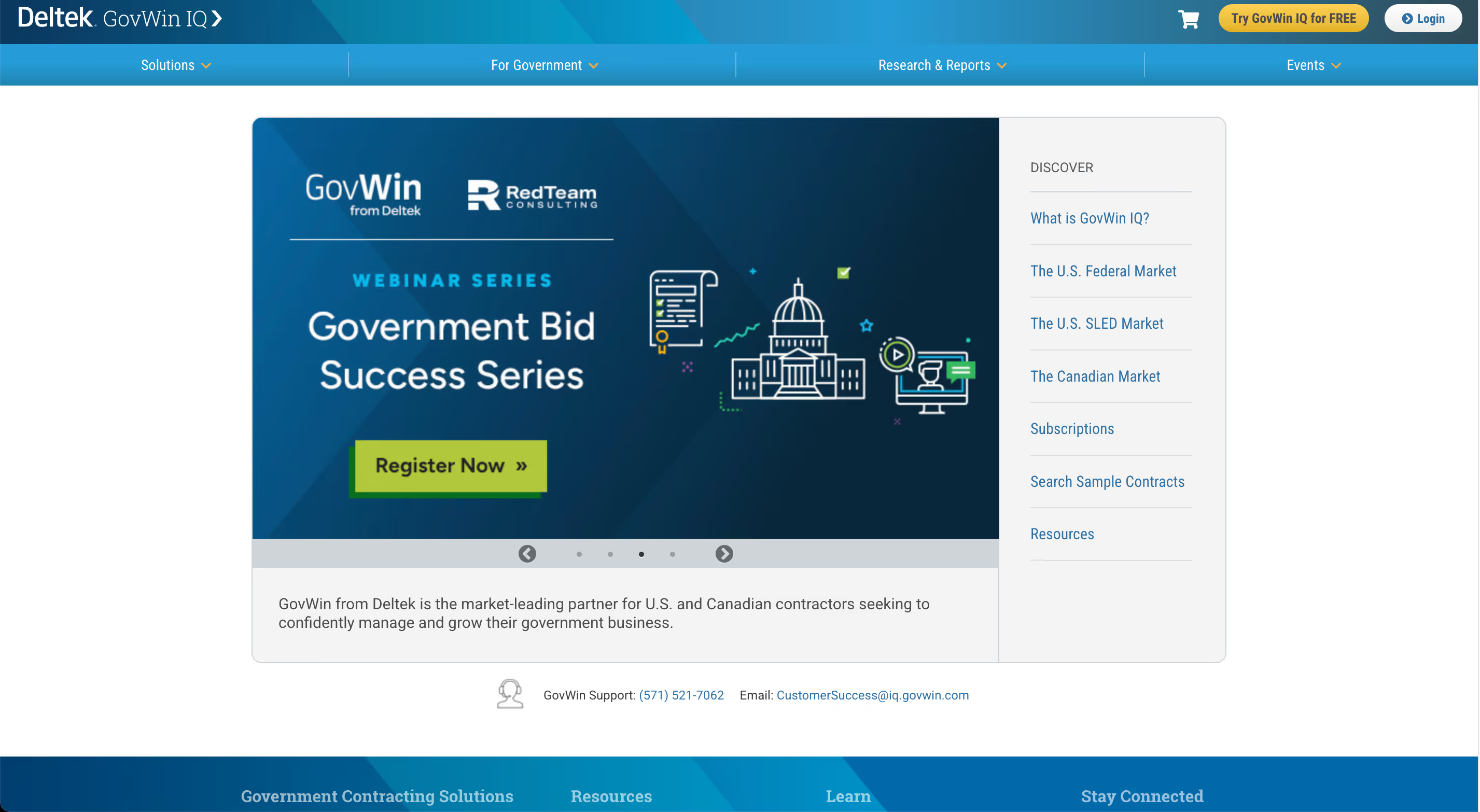
GovWin IQ is a leading AI-driven platform that helps vendors discover, track, and win government contracting opportunities. It provides predictive analytics, competitor insights, and a centralized view of federal, state, and local procurement trends, enabling vendors to plan strategically and engage with agencies early.
Top Features:
- Predictive Opportunity Tracking: Identifies upcoming federal and state RFPs using AI forecasts, helping vendors act before opportunities reach public portals.
- Competitor Analysis: Provides insights on competing vendors, past bids, and contract awards to help shape winning strategies with minimal guesswork.
- Market Intelligence Reports: Delivers AI-powered reports on spending trends, procurement priorities, and agency needs to inform better business decisions.
2. BidNet Direct
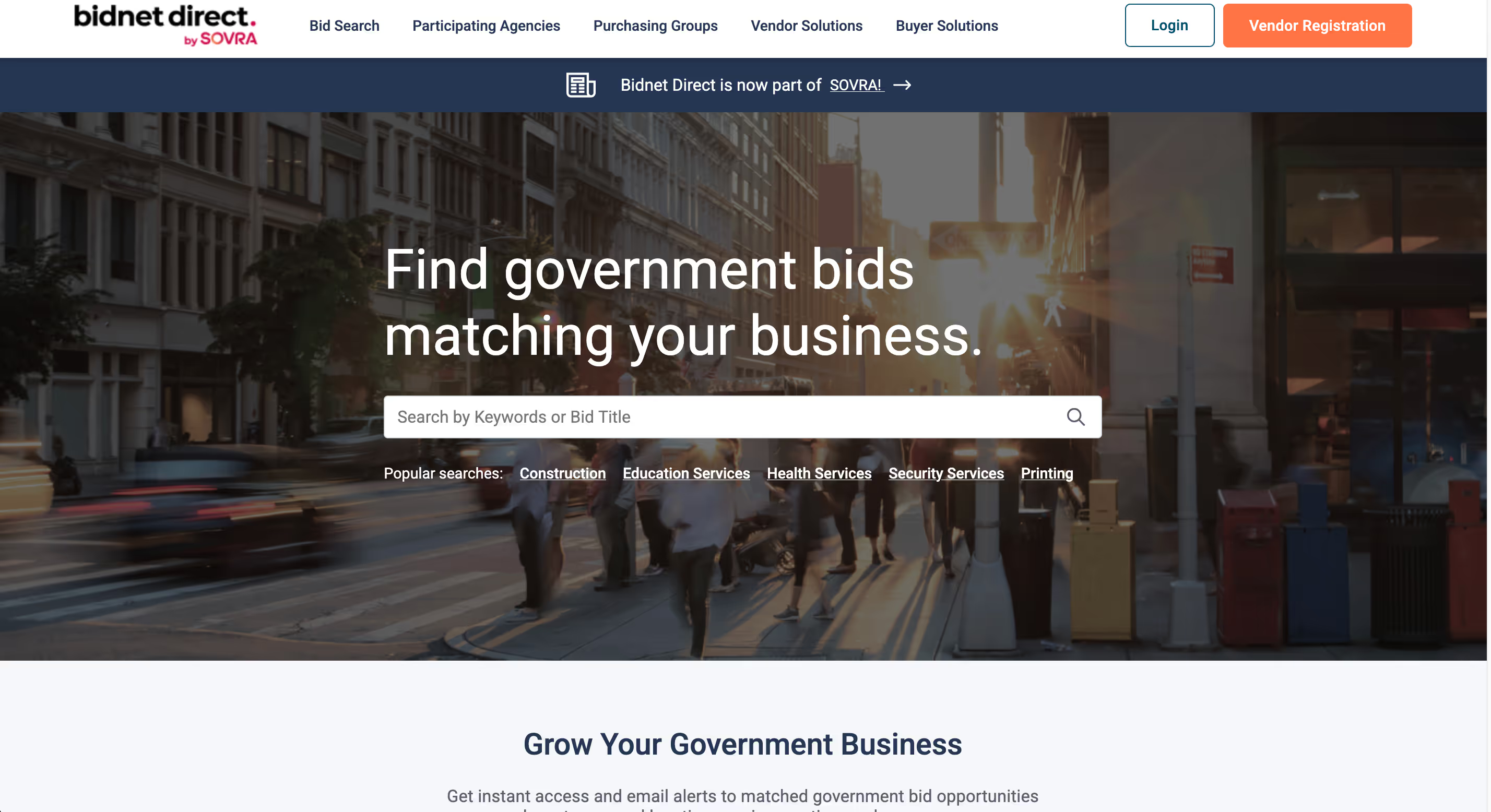
BidNet Direct connects vendors with public sector opportunities using AI-powered bid matching and customized alerts. It streamlines RFP searches, automates proposal preparation, and provides advanced filtering, helping vendors save time and submit more relevant, high-quality proposals for federal, state, and municipal contracts.
Top Features:
- AI Bid Matching: Analyzes contract databases to surface relevant RFPs tailored to vendor capabilities, ensuring no critical opportunity is missed.
- Custom Alerts: Sends real-time notifications about new bids, RFQs, or addendums, helping vendors respond quickly to opportunities.
- Document Automation: Auto-generates proposal outlines and pre-populates key sections, cutting response times significantly while improving consistency.
3. Jaggaer

Jaggaer offers an AI-driven procurement suite trusted by government entities for supplier management, contract compliance, and risk assessment. Its robust analytics and intelligent workflows streamline sourcing and vendor qualification, while predictive models help agencies and vendors optimize costs and ensure compliance throughout the procurement lifecycle.
Top Features:
- Supplier Risk Scoring: Uses AI to evaluate vendor stability, compliance certifications, and performance metrics for risk-free supplier selection.
- Predictive Pricing Models: Analyzes historical contracts and market trends to suggest cost benchmarks and competitive bid pricing.
- Workflow Automation: Simplifies sourcing and onboarding with automated approvals, task assignments, and compliance verification.
4. SAP Ariba
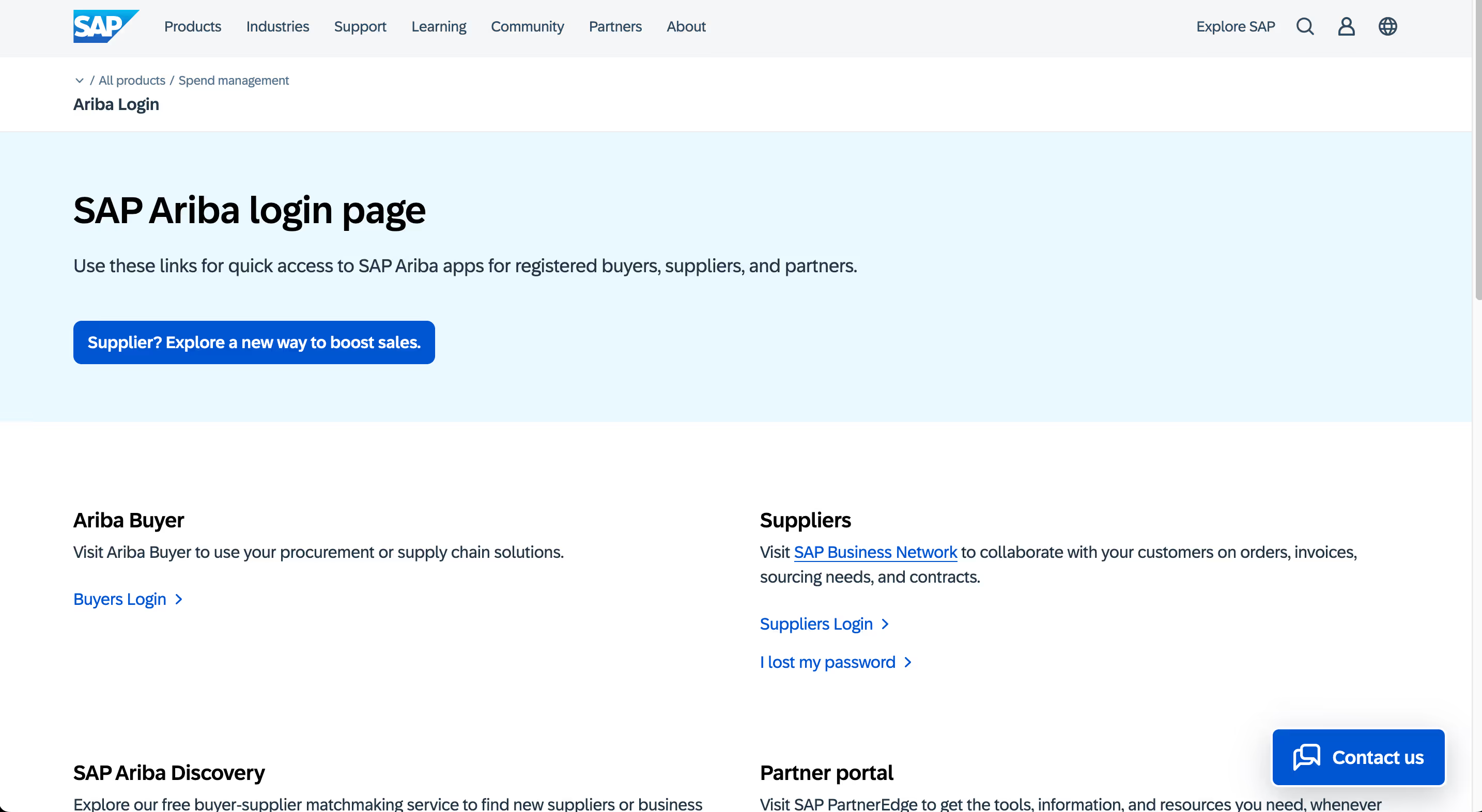
SAP Ariba is an AI-powered procurement platform that helps agencies automate sourcing, bidding, and contract lifecycle management. Known for its integration capabilities, Ariba improves vendor collaboration, enhances compliance checks, and provides advanced spend analytics for smarter, data-driven decision-making in government procurement processes.
Top Features:
- Contract Compliance Checks: Automatically scans contracts for missing clauses or regulatory requirements, minimizing risks and legal disputes.
- Spend Analytics: AI-driven insights into procurement spending patterns to optimize budgets and reduce unnecessary costs.
- Supplier Collaboration Hub: Centralizes communication with vendors, allowing real-time updates, bid submissions, and clarifications.
5. LogicGate Risk Cloud
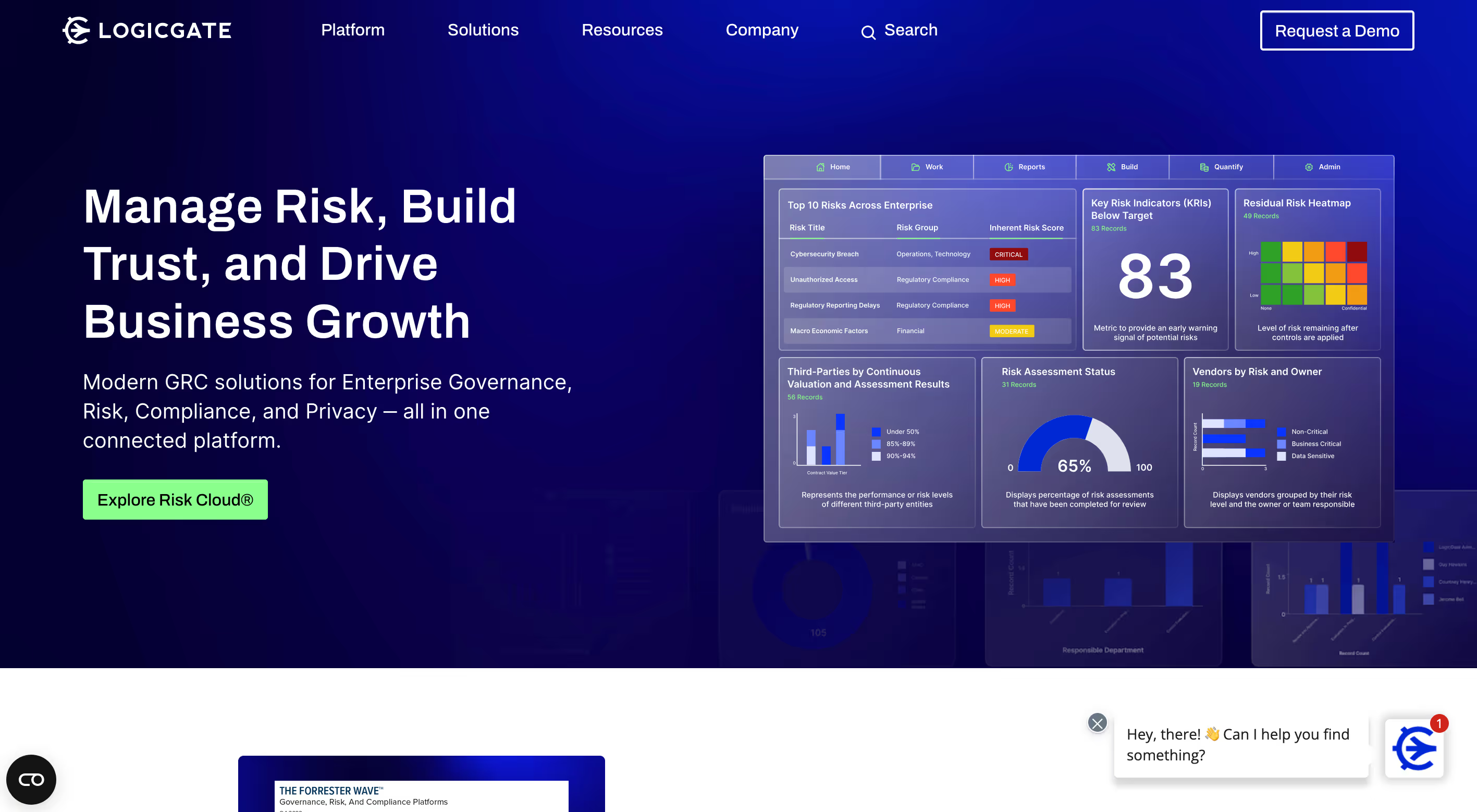
LogicGate Risk Cloud specializes in risk management and compliance automation. Its AI-powered platform assists government agencies in monitoring vendor risks, automating regulatory reporting, and maintaining audit trails. It provides actionable insights that reduce compliance errors and strengthen oversight during complex procurement processes.
Top Features:
- AI-Powered Risk Detection: Flags high-risk vendors by analyzing financial health, legal history, and compliance gaps in real-time.
- Audit-Ready Workflows: Tracks approvals, changes, and decisions, ensuring every step of procurement is documented for regulatory audits.
- Automated Reporting: Generates compliance and performance reports on-demand, saving time and reducing manual oversight.
With these tools, agencies and vendors can modernize procurement by blending automation, compliance, and actionable insights. Next, let’s explore how vendors specifically benefit from AI-driven solutions like Inventive.ai.
Also Read: RFP Response Best Practices: Proven Steps and Tips to Win More
How Inventive.ai Supports Government Vendors?

Responding to government RFPs is notoriously time-consuming, compliance-heavy, and resource-intensive. Vendors must navigate complex documentation, respond to dozens (sometimes hundreds) of questions, and ensure alignment with strict regulatory standards, all under tight deadlines. Inventive AI is built to tackle these exact challenges for vendors in government procurement.
Here’s how Inventive AI helps vendors streamline public sector RFP workflows:
1. 90% Faster RFP Response Times
Government agencies typically allow limited response windows, and missing deadlines can mean missing out on million-dollar opportunities.
Inventive AI’s AI RFP Agent automatically generates accurate first drafts by pulling from approved content libraries, past proposals, and integrated systems (like SharePoint or Slack). This enables teams to submit timely, compliant responses—without the scramble.
2. 50% Higher Win Rates
Government RFPs are won on precision. Inventive AI ensures every response aligns with your unique “Win Themes,” automatically identifying gaps and strengthening your proposals with relevant, differentiated messaging tailored to agency needs.
The platform continuously refines your proposal content by learning from past submissions, helping you increase quality and stand out from the competition.
3. Centralized Knowledge for Reuse
Government RFPs often ask the same questions in different formats. Inventive AI acts as a single source of truth, storing past responses, security questionnaires, and certifications in a centralized, searchable hub. Proposal teams can reuse verified content instead of reinventing the wheel, cutting hours of duplication.
4. Supports Complex, Multi-Team Collaboration
From legal and security to pricing and compliance teams, government RFPs often require input from multiple departments. Inventive AI integrates with tools like Slack, Microsoft Teams, and email to streamline cross-functional collaboration. Teams can comment, approve, and update responses in real time without switching tools.
Conclusion
Government RFPs are high-stakes, high-effort, and traditionally slow-moving. Manual workflows, outdated content libraries, and disconnected teams lead to delayed submissions and missed opportunities. But AI is taking it a step ahead.
Whether you're bidding for federal transportation projects or responding to public health RFIs, Inventive AI ensures you meet tight deadlines without compromising quality.
Tired of chasing RFP deadlines with outdated content?
With Inventive AI’s AI-Powered RFP Response Software, you can:
- Generate proposal drafts in minutes, not days
- Reuse approved responses from a centralised hub
- Collaborate seamlessly across legal, technical, and proposal teams
- Increase your deal win rate by over 50%
Ready to modernize your government RFP process? Request a demo and discover how Inventive AI can help your team respond faster, more accurately and win more government contracts.


